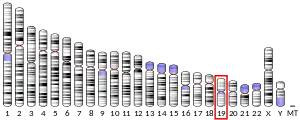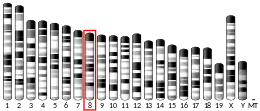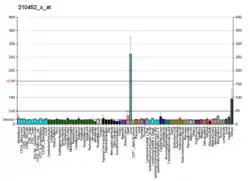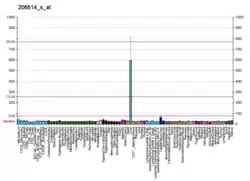CYP4F2
Leukotriene-B(4) omega-hydroxylase 1 is an enzyme involved in the metabolism various endogenous substrates and xenobiotics. Most notable substrate of the enzyme is leukotriene B4, a potent mediator of inflammation. The enzyme is encoded by the CYP4F2 gene in humans.[5][6][7]
Function
The Leukotriene-B(4) omega-hydroxylase 1, or simply the CYP4F2 enzyme protein, encoded by CYP4F2 gene, is a member of the cytochrome P450 superfamily of enzymes. The CYP4F2 gene belongs to a cluster of cytochrome P450 genes on chromosome 19. Another member of this family, CYP4F11, is approximately 16 kb away.[7]
The enzyme is called Leukotriene-B(4) omega-hydroxylase 1, because it starts the process of inactivating and degrading leukotriene B4, a potent mediator of inflammation.
The cytochrome P450 enzymes are monooxygenases which catalyze many reactions involved in drug metabolism and synthesis of cholesterol, steroids, fatty acids, and other lipids.
The CYP4F2 enzyme protein presents in endoplasmic reticulum.
The enzyme CYP4F2 is involved in the metabolism of various endogenous substrates, including fatty acids, eicosanoids and vitamins.[8] It controls the bioavailability of Vitamin E. It also controls the bioavailability of Vitamin K, a co-factor that is required for blood to clot. Variations in the CYP4F2 gene that affect the bioavailability of Vitamin K also affect the dosing of Vitamin K antagonists such as warfarin, coumarin or acenocoumarol.[9][10] The enzyme also regulates bioactivation of various drugs, e.g. the anti-malarial drug pafuramidine and the anti-parasitic drug furamidine. It also plays a role in renal water homeostasis.[11]
Inactivation of Leukotriene B4
Arachidonic acid is a precursor of the eicosanoid molecules that control immune response and inflammation. Acute inflammation on injury or infection protects the body from pathogens. It should also be taken into consideration that if inflammation is continuing for a notably long time, healthy cells and tissues are damaged. Thus, the inflammation must be carefully controlled. Leukotriene B4 is a pro-inflammatory eicosanoid with strong chemoattractant properties. It can be rapidly produced by activated innate immune cells, such as neutrophils, macrophages and mast cells.[12] It induces the activation of polymorphonuclear leukocytes, monocytes and fibroblasts, the production of superoxide and the release of cytokines to attract neutrophils.[13][14][15][16] CYP4F2 starts the process of inactivating and degrading leukotriene B4, by converting it to its ω-hydroxylated metabolite 20-hydroxyleukotriene B4 in human liver microsomes.[17] CYP4F2 then coverts 20-hydroxyleukotriene B4 to 20-oxoleukotriene B4 and then to 20-carboxyleukotrene B4.[18]
Chain shortening
It is α-, β-, and ω-oxidation of fatty acid carbon chains that degrades the acids, with preferred pathway being the β-oxidation in the mitochondria and peroxisomes. Very long chain fatty acids cannot be β-oxidized. The number of carbon atoms in the chains of such acids exceeds 22. Such chains must be shortened before being oxidized by mitochondria. The CYP4F2 enzyme is involved in catalyzing the ω-oxidation and chain shortening of such acids.[19]
Metabolism of vitamins
The enzyme plays an important role in vitamin metabolism by chain shortening.[20][21][22][23]
CYP4F2 is the only known enzyme to ω-hydroxylate tocotrienols and tocopherols (types of Vitamin E), thus making it a key regulator of circulating plasma Vitamin E levels.[24][16][25] It catalyzes ω-hydroxylation of the phytyl chain of tocopherols (forms of vitamin E), with preference for gamma-tocopherols over α-tocopherols, thus promoting retention of α-tocopherols in tissues.[26]
Both types of Vitamin K (K1 and K2) can be used as co-factors for γ-glutamyl carboxylase, an enzyme that catalyzes the posttranslational modification of Vitamin K-dependent proteins, thus biochemically activating the proteins involved in blood coagulation and bone mineralization. CYP4F2 ω-xydroxylates and inactivates Vitamin K. As a result, CYP4F2 becomes vital negative regulator of circulating Vitamin K levels.[27][28]
Production of 20-HETE
CYP4F2 along with CYP4A22, CYP4A11, CYP4F3 and CYP2U1 also metabolize arachidonic acid to 20-Hydroxyeicosatetraenoic acid (20-HETE) by an ω-oxidation reaction, with the predominant 20-HETE-synthesizing enzymes in humans being CYP4F2, followed by CYP4A11. 20-HETE regulates blood flow, vascularization, blood pressure, and kidney tubule absorption of ions in rodents and possibly humans.[29] The CYP4F2*3 (rs2108622) polymorphism (the enzyme protein with valine residue replaced to methionine residue at position 433) leads to reduced capacity to metabolize arachidonic acid to 20-HETE, but increased urinary excretion of 20-HETE.[15][30] Researchers have identified at least 3 more single-nucleotide polymorphisms (2024C>G P85A; 80 C>T A27V rs771576634; 139C>T R47C rs115517770) which may affect conversion of arachidonic acid to HETE-20.[31]
Metabolism of fatty acids
Members of the CYP4A and CYP4F sub-families may also ω-hydroxylate and thereby reduce the activity of various fatty acid metabolites of arachidonic acid including leukotriene B4, 5-HETE, 5-oxo-eicosatetraenoic acid, 12-HETE, and several prostaglandins that are involved in regulating various inflammatory, vascular, and other responses in animals and humans.[18][16] This hydroxylation-induced inactivation may underlie the proposed roles of the cytochromes in dampening inflammatory responses and the reported associations of certain CYP4F2 single-nucleotide polymorphisms (SNPs) with human Crohn's disease[32][33] and Coeliac disease.[16][34][35]
Tye enzyme catalyzes ω-hydroxylation of 3-hydroxy fatty acids.[36] It converts monoepoxides of linoleic acid leukotoxin and isoleukotoxin to ω-hydroxylated metabolites.[37] It also contributes to the degradation of very long-chain fatty acids by catalyzing successive ω-oxidations and chain shortening.[38][39]
Anti-parasitic drugs
Pafuramidine is a prodrug of furamidine, an antiparasitic drug. There are at least two studies which determined that CYP4F2 is one of the enzymes responsible for the conversion of pafuramidine to furamidine in human liver microsomes and human enteric microsomes.[19][40][41]
Genetic variants
The T allele at rs2108622, which has been designated as CYP4F2*3 in the Human CYP Allele Nomenclature Database by the Pharmacogene Variation Consortium, produces the enzyme with valine residue replaced to methionine residue at position 433, a single-nucleotide polymorphism, resulting in reduced CYP4F2 enzyme activity for some substances,[42] due to decrease in steady-state hepatic concentrations of the enzyme.[27] This polymorphism, CYP4F2*3 (1347C>T; NM_001082.5:c.1297G>A; p. Val433Met; rs2108622), is the most studied and most pharmacogenetically relevant. Another polymorphism, CYP4F2*2 (NM_001082.4:c.34T>G; p.Trp12Gly; rs3093105), increases specific enzyme activity for some substances.
Studies have shown that CYP4F2*3 polymorphysm has a role in eicosanoid and Vitamin E metabolism,[25][43] in the bioavailability of Vitamin K, in affecting doses of warfarin[44][45] or coumarin,[10] and is also associated with increased blood pressure,[30][46][47][48] with increased risk of cerebral infarction (i.e. ischemic stroke)[49][50][51] and myocardial infarction.[52][53]
Research
The molecular mediators, inducers and inhibitors, that regulate CYP4F2 expression, have mostly been elucidated in in vitro systems:[9]
- There have been findings that retinoic acid (a metabolite of vitamin A1)[54] and saturated fatty acids, such as lauric acid and stearic acid, induce CYP4F2.[55] Besides that, there were findings that lovastatin induce CYP4F2.[56]
- There also have been findings that CYP4F2 is inhibited by peroxisomal proliferators, such as clofibrate, pirinixic acid, nafenopin and tibric acid; the anti-fungal drug ketoconazole,[57] and sesamin[58] - a molecule found in sesame oil and sesame seeds, also inhibit CYP4F2. Another study has shown that quercetin, tranylcypromine, and disulfiram also inhibit CYP4F2.[59]
- A study has found that the following substances do not inhibit CYP4F2: brincidofovir and azoles (except ketoconazole), namely posaconazole, fluconazole, and voriconazole.[59]
With the exception of ketoconazole and sesamin, these findings have not been confirmed in clinical studies.[9][60] The inhibitory effect of ketoconazole has been confirmed by a study of 21 participants with different CYP4F2*3 variants enrolled (8 for *1/*1, 7 for *1/*3, and 6 for *3/*3).[57] The inhibitory effect of sesamin has been confirmed by a randomized, controlled crossover trial, where 33 overweight men and women consumed 25 grams per day of sesame (approximately 50 mg/d of sesame lignan) for 5 weeks, resulting in a 28% decrease in plasma and a 32% decrease in urinary 20-HETE, while urinary sodium, potassium, and blood pressure were not affected.[61]
References
- GRCh38: Ensembl release 89: ENSG00000186115 - Ensembl, May 2017
- GRCm38: Ensembl release 89: ENSMUSG00000003484 - Ensembl, May 2017
- "Human PubMed Reference:". National Center for Biotechnology Information, U.S. National Library of Medicine.
- "Mouse PubMed Reference:". National Center for Biotechnology Information, U.S. National Library of Medicine.
- Chen L, Hardwick JP (January 1993). "Identification of a new P450 subfamily, CYP4F1, expressed in rat hepatic tumors". Archives of Biochemistry and Biophysics. 300 (1): 18–23. doi:10.1006/abbi.1993.1003. PMID 8424651.
- Kikuta Y, Kusunose E, Kondo T, Yamamoto S, Kinoshita H, Kusunose M (July 1994). "Cloning and expression of a novel form of leukotriene B4 omega-hydroxylase from human liver". FEBS Letters. 348 (1): 70–4. doi:10.1016/0014-5793(94)00587-7. PMID 8026587. S2CID 83948293.
- "CYP4F2 cytochrome P450 family 4 subfamily F member 2". National Center for Biotechnology Information. Retrieved 30 November 2020.
This gene encodes a member of the cytochrome P450 superfamily of enzymes. The cytochrome P450 proteins are monooxygenases which catalyze many reactions involved in drug metabolism and synthesis of cholesterol, steroids and other lipids. This protein localizes to the endoplasmic reticulum. The enzyme starts the process of inactivating and degrading leukotriene B4, a potent mediator of inflammation. This gene is part of a cluster of cytochrome P450 genes on chromosome 19. Another member of this family, CYP4F11, is approximately 16 kb away.
 This article incorporates text from this source, which is in the public domain.
This article incorporates text from this source, which is in the public domain. - "CYP4F2 Gene".
- "Very Important Pharmacogene: CYP4F2". PharmGKB. Stanford University.
- Danese E, Raimondi S, Montagnana M, Tagetti A, Langaee T, Borgiani P, et al. (June 2019). "Effect of CYP4F2, VKORC1, and CYP2C9 in Influencing Coumarin Dose: A Single-Patient Data Meta-Analysis in More Than 15,000 Individuals". Clinical Pharmacology and Therapeutics. 105 (6): 1477–1491. doi:10.1002/cpt.1323. PMC 6542461. PMID 30506689.
- Lasker JM, Chen WB, Wolf I, Bloswick BP, Wilson PD, Powell PK (February 2000). "Formation of 20-hydroxyeicosatetraenoic acid, a vasoactive and natriuretic eicosanoid, in human kidney. Role of Cyp4F2 and Cyp4A11". The Journal of Biological Chemistry. 275 (6): 4118–26. doi:10.1074/jbc.275.6.4118. PMID 10660572. S2CID 41956184.
- "The Role of Leukotriene B4 in Allergic Diseases".
- Yokomizo T, Izumi T, Shimizu T (January 2001). "Leukotriene B4: metabolism and signal transduction". Archives of Biochemistry and Biophysics. 385 (2): 231–41. doi:10.1006/abbi.2000.2168. PMID 11368003.
- Kalsotra A, Strobel HW (December 2006). "Cytochrome P450 4F subfamily: at the crossroads of eicosanoid and drug metabolism". Pharmacology & Therapeutics. 112 (3): 589–611. doi:10.1016/j.pharmthera.2006.03.008. PMID 16926051.
- Stec DE, Roman RJ, Flasch A, Rieder MJ (June 2007). "Functional polymorphism in human CYP4F2 decreases 20-HETE production". Physiological Genomics. 30 (1): 74–81. doi:10.1152/physiolgenomics.00003.2007. PMID 17341693.
- Hardwick JP (June 2008). "Cytochrome P450 omega hydroxylase (CYP4) function in fatty acid metabolism and metabolic diseases". Biochemical Pharmacology. 75 (12): 2263–75. doi:10.1016/j.bcp.2008.03.004. PMID 18433732.
- Jin R, Koop DR, Raucy JL, Lasker JM (November 1998). "Role of human CYP4F2 in hepatic catabolism of the proinflammatory agent leukotriene B4". Archives of Biochemistry and Biophysics. 359 (1): 89–98. doi:10.1006/abbi.1998.0880. PMID 9799565.
- Kikuta Y, Kusunose E, Sumimoto H, Mizukami Y, Takeshige K, Sakaki T, et al. (July 1998). "Purification and characterization of recombinant human neutrophil leukotriene B4 ω-hydroxylase (cytochrome P450 4F3)". Archives of Biochemistry and Biophysics. 355 (2): 201–5. doi:10.1006/abbi.1998.0724. PMID 9675028.
- Alvarellos ML, Sangkuhl K, Daneshjou R, Whirl-Carrillo M, Altman RB, Klein TE (January 2015). "PharmGKB summary: very important pharmacogene information for CYP4F2". Pharmacogenetics and Genomics. 25 (1): 41–7. doi:10.1097/FPC.0000000000000100. PMC 4261059. PMID 25370453.
- Martha H. Stipanuk, Marie A. Caudill (2018). Biochemical, Physiological, and Molecular Aspects of Human Nutrition - E-Book (4 ed.). Elsevier Health Sciences. p. 711. ISBN 9780323402132.CS1 maint: uses authors parameter (link)
- Volker Böhm (2018). Vitamin E. p. 60. ISBN 978-3-03842-906-7.
- Fred Snyder (6 December 2012). Lipid metabolism in mammals. Springer Science & Business Media. p. 44. ISBN 978-1-4684-2832-2.
- S. Numa, ed. (January 1984). Fatty Acid Metabolism and its Regulation. Elsevier. p. 132. ISBN 0444805281.
- Parker RS, Sontag TJ, Swanson JE, McCormick CC (December 2004). "Discovery, characterization, and significance of the cytochrome P450 omega-hydroxylase pathway of vitamin E catabolism". Annals of the New York Academy of Sciences. 1031: 13–21. doi:10.1196/annals.1331.002. PMID 15753130. S2CID 33584273.
- Bardowell SA, Stec DE, Parker RS (November 2010). "Common variants of cytochrome P450 4F2 exhibit altered vitamin E-{omega}-hydroxylase specific activity". The Journal of Nutrition. 140 (11): 1901–6. doi:10.3945/jn.110.128579. PMC 2955872. PMID 20861217.
- Sontag TJ, Parker RS (July 2002). "Cytochrome P450 omega-hydroxylase pathway of tocopherol catabolism. Novel mechanism of regulation of vitamin E status". The Journal of Biological Chemistry. 277 (28): 25290–6. doi:10.1074/jbc.M201466200. PMID 11997390.
- Danese E, Montagnana M, Johnson JA, Rettie AE, Zambon CF, Lubitz SA, Suarez-Kurtz G, Cavallari LH, Zhao L, Huang M, Nakamura Y, Mushiroda T, Kringen MK, Borgiani P, Ciccacci C, Au NT, Langaee T, Siguret V, Loriot MA, Sagreiya H, Altman RB, Shahin MH, Scott SA, Khalifa SI, Chowbay B, Suriapranata IM, Teichert M, Stricker BH, Taljaard M, et al. (December 2012). "Impact of the CYP4F2 p.V433M polymorphism on coumarin dose requirement: systematic review and meta-analysis". Clinical Pharmacology and Therapeutics. 92 (6): 746–56. doi:10.1038/clpt.2012.184. PMC 3731755. PMID 23132553.
- McDonald MG, Rieder MJ, Nakano M, Hsia CK, Rettie AE (June 2009). "CYP4F2 is a vitamin K1 oxidase: An explanation for altered warfarin dose in carriers of the V433M variant". Molecular Pharmacology. 75 (6): 1337–46. doi:10.1124/mol.109.054833. PMC 2684883. PMID 19297519.
- Hoopes SL, Garcia V, Edin ML, Schwartzman ML, Zeldin DC (July 2015). "Vascular actions of 20-HETE". Prostaglandins & Other Lipid Mediators. 120: 9–16. doi:10.1016/j.prostaglandins.2015.03.002. PMC 4575602. PMID 25813407.
- Ward NC, Croft KD, Puddey IB, Phillips M, van Bockxmeer F, Beilin LJ, Barden AE (July 2014). "The effect of a single nucleotide polymorphism of the CYP4F2 gene on blood pressure and 20-hydroxyeicosatetraenoic acid excretion after weight loss" (PDF). Journal of Hypertension. 32 (7): 1495–502, discussion 1502. doi:10.1097/HJH.0000000000000208. PMID 24984178. S2CID 6754178.
- Kim, W. Y.; Lee, S. J.; Min, J.; Oh, K. S.; Kim, D. H.; Kim, H. S.; Shin, J. G. (2018). "Identification of novel CYP4F2 genetic variants exhibiting decreased catalytic activity in the conversion of arachidonic acid to 20-hydroxyeicosatetraenoic acid (20-HETE)". Prostaglandins, Leukotrienes, and Essential Fatty Acids. 131: 6–13. doi:10.1016/j.plefa.2018.02.003. PMID 29628049.
- Costea I, Mack DR, Lemaitre RN, Israel D, Marcil V, Ahmad A, Amre DK (April 2014). "Interactions between the dietary polyunsaturated fatty acid ratio and genetic factors determine susceptibility to pediatric Crohn's disease". Gastroenterology. 146 (4): 929–31. doi:10.1053/j.gastro.2013.12.034. PMID 24406470.
- Costea I, Mack DR, Israel D, Morgan K, Krupoves A, Seidman E, et al. (December 2010). "Genes involved in the metabolism of poly-unsaturated fatty-acids (PUFA) and risk for Crohn's disease in children & young adults". PLOS ONE. 5 (12): e15672. Bibcode:2010PLoSO...515672C. doi:10.1371/journal.pone.0015672. PMC 3004960. PMID 21187935.
- Curley CR, Monsuur AJ, Wapenaar MC, Rioux JD, Wijmenga C (November 2006). "A functional candidate screen for coeliac disease genes". European Journal of Human Genetics. 14 (11): 1215–22. doi:10.1038/sj.ejhg.5201687. PMID 16835590.
- Corcos L, Lucas D, Le Jossic-Corcos C, Dréano Y, Simon B, Plée-Gautier E, et al. (April 2012). "Human cytochrome P450 4F3: structure, functions, and prospects". Drug Metabolism and Drug Interactions. 27 (2): 63–71. doi:10.1515/dmdi-2011-0037. PMID 22706230. S2CID 5258044.
- Dhar M, Sepkovic DW, Hirani V, Magnusson RP, Lasker JM (March 2008). "Omega oxidation of 3-hydroxy fatty acids by the human CYP4F gene subfamily enzyme CYP4F11". Journal of Lipid Research. 49 (3): 612–24. doi:10.1194/jlr.M700450-JLR200. PMID 18065749. S2CID 28835933.
- Le Quéré V, Plée-Gautier E, Potin P, Madec S, Salaün JP (August 2004). "Human CYP4F3s are the main catalysts in the oxidation of fatty acid epoxides". Journal of Lipid Research. 45 (8): 1446–58. doi:10.1194/jlr.M300463-JLR200. PMID 15145985. S2CID 6065789.
- Sanders RJ, Ofman R, Duran M, Kemp S, Wanders RJ (May 2006). "Omega-oxidation of very long-chain fatty acids in human liver microsomes. Implications for X-linked adrenoleukodystrophy". The Journal of Biological Chemistry. 281 (19): 13180–7. doi:10.1074/jbc.M513481200. PMID 16547005.
- Sanders RJ, Ofman R, Dacremont G, Wanders RJ, Kemp S (June 2008). "Characterization of the human omega-oxidation pathway for omega-hydroxy-very-long-chain fatty acids". FASEB Journal. 22 (6): 2064–71. doi:10.1096/fj.07-099150. hdl:1854/LU-745741. PMID 18182499. S2CID 36659127.
- Wang MZ, Wu JQ, Bridges AS, Zeldin DC, Kornbluth S, Tidwell RR, Hall JE, Paine MF (November 2007). "Human enteric microsomal CYP4F enzymes O-demethylate the antiparasitic prodrug pafuramidine". Drug Metabolism and Disposition: The Biological Fate of Chemicals. 35 (11): 2067–75. doi:10.1124/dmd.107.016428. PMC 2364724. PMID 17709372.
- Wang MZ, Saulter JY, Usuki E, Cheung YL, Hall M, Bridges AS, et al. (December 2006). "CYP4F enzymes are the major enzymes in human liver microsomes that catalyze the O-demethylation of the antiparasitic prodrug DB289 [2,5-bis(4-amidinophenyl)furan-bis-O-methylamidoxime]". Drug Metabolism and Disposition. 34 (12): 1985–94. doi:10.1124/dmd.106.010587. PMC 2077835. PMID 16997912.
- Schmölz L, Birringer M, Lorkowski S, Wallert M (February 2016). "Complexity of vitamin E metabolism". World Journal of Biological Chemistry. 7 (1): 14–43. doi:10.4331/wjbc.v7.i1.14. PMC 4768118. PMID 26981194.
- Major JM, Yu K, Wheeler W, Zhang H, Cornelis MC, Wright ME, et al. (October 2011). "Genome-wide association study identifies common variants associated with circulating vitamin E levels". Human Molecular Genetics. 20 (19): 3876–83. doi:10.1093/hmg/ddr296. PMC 3168288. PMID 21729881.
- Zhuang W, Wu D, Wang Z (January 2014). "[Influence of warfarin related genes and non- genetic factors on administrative dose in Shanghai area]". Zhonghua Xue Ye Xue Za Zhi = Zhonghua Xueyexue Zazhi (in Chinese). 35 (1): 13–7. doi:10.3760/cma.j.issn.0253-2727.2014.01.004. PMID 24602724.
- Zhang JE, Klein K, Jorgensen AL, Francis B, Alfirevic A, Bourgeois S, et al. (2017). "CYP4F12 Genes on Liver mRNA Levels and Warfarin Response". Frontiers in Pharmacology. 8: 323. doi:10.3389/fphar.2017.00323. PMC 5449482. PMID 28620303.
- Ward NC, Tsai IJ, Barden A, van Bockxmeer FM, Puddey IB, Hodgson JM, Croft KD (May 2008). "A single nucleotide polymorphism in the CYP4F2 but not CYP4A11 gene is associated with increased 20-HETE excretion and blood pressure". Hypertension. 51 (5): 1393–8. doi:10.1161/HYPERTENSIONAHA.107.104463. PMID 18391101. S2CID 23954075.
- Munshi A, Sharma V, Kaul S, Al-Hazzani A, Alshatwi AA, Shafi G, et al. (February 2012). "Association of 1347 G/A cytochrome P450 4F2 (CYP4F2) gene variant with hypertension and stroke". Molecular Biology Reports. 39 (2): 1677–82. doi:10.1007/s11033-011-0907-y. PMID 21625857. S2CID 14217802.
- Fu Z, Nakayama T, Sato N, Izumi Y, Kasamaki Y, Shindo A, et al. (September 2008). "Haplotype-based case-control study of the human CYP4F2 gene and essential hypertension in Japanese subjects". Hypertension Research. 31 (9): 1719–26. doi:10.1291/hypres.31.1719. PMID 18971550.
- Ding H, Cui G, Zhang L, Xu Y, Bao X, Tu Y, et al. (March 2010). "Association of common variants of CYP4A11 and CYP4F2 with stroke in the Han Chinese population". Pharmacogenetics and Genomics. 20 (3): 187–94. doi:10.1097/FPC.0b013e328336eefe. PMC 3932492. PMID 20130494.
- Fu Z, Nakayama T, Sato N, Izumi Y, Kasamaki Y, Shindo A, et al. (November 2008). "A haplotype of the CYP4F2 gene is associated with cerebral infarction in Japanese men". American Journal of Hypertension. 21 (11): 1216–23. doi:10.1038/ajh.2008.276. PMID 18787519.
- Fava C, Montagnana M, Almgren P, Rosberg L, Lippi G, Hedblad B, et al. (August 2008). "The V433M variant of the CYP4F2 is associated with ischemic stroke in male Swedes beyond its effect on blood pressure". Hypertension. 52 (2): 373–80. doi:10.1161/HYPERTENSIONAHA.108.114199. PMID 18574070. S2CID 6884532.
- Fu Z, Nakayama T, Sato N, Izumi Y, Kasamaki Y, Shindo A, et al. (March 2009). "A haplotype of the CYP4F2 gene associated with myocardial infarction in Japanese men". Molecular Genetics and Metabolism. 96 (3): 145–7. doi:10.1016/j.ymgme.2008.11.161. PMID 19097922.
- Wang T, Xu L (September 2019). "Circulating Vitamin E Levels and Risk of Coronary Artery Disease and Myocardial Infarction: A Mendelian Randomization Study". Nutrients. 11 (9): 2153. doi:10.3390/nu11092153. PMC 6770080. PMID 31505768.
- Zhang X, Hardwick JP (December 2000). "Regulation of CYP4F2 leukotriene B4 omega-hydroxylase by retinoic acids in HepG2 cells". Biochemical and Biophysical Research Communications. 279 (3): 864–71. doi:10.1006/bbrc.2000.4020. PMID 11162441.
- Zhang X, Chen L, Hardwick JP (June 2000). "Promoter activity and regulation of the CYP4F2 leukotriene B(4) omega-hydroxylase gene by peroxisomal proliferators and retinoic acid in HepG2 cells". Archives of Biochemistry and Biophysics. 378 (2): 364–76. doi:10.1006/abbi.2000.1836. PMID 10860554.
- Hsu MH, Savas U, Griffin KJ, Johnson EF (February 2007). "Regulation of human cytochrome P450 4F2 expression by sterol regulatory element-binding protein and lovastatin". The Journal of Biological Chemistry. 282 (8): 5225–36. doi:10.1074/jbc.M608176200. PMID 17142457.
- Park, J. W.; Kim, K. A.; Park, J. Y. (2019). "Effects of Ketoconazole, a CYP4F2 Inhibitor, and CYP4F2*3 Genetic Polymorphism on Pharmacokinetics of Vitamin K1". Journal of Clinical Pharmacology. 59 (11): 1453–1461. doi:10.1002/jcph.1444. PMID 31134657. S2CID 167218512.
- Watanabe, H.; Yamaori, S.; Kamijo, S.; Aikawa, K.; Ohmori, S. (2020). "In Vitro Inhibitory Effects of Sesamin on CYP4F2 Activity". Biological & Pharmaceutical Bulletin. 43 (4): 688–692. doi:10.1248/bpb.b19-00953. PMID 32238710.
- Tippin T, Chladek J, Keilholz L, Usuki E, Ogilvie B, Van Sickle K, Mommeja-Marin H, Grossi IM, Trost L (January 2014). "CYP4F2 is The Major Cytochrome P450 Enzyme Involved in CMX001 Metabolism". Drug Metabolism Reviews. 45: 84–85.
- Andrus MR (February 2004). "Oral anticoagulant drug interactions with statins: case report of fluvastatin and review of the literature". Pharmacotherapy. 24 (2): 285–90. doi:10.1592/phco.24.2.285.33137. PMID 14998226. S2CID 19086011.
- Wu, J. H.; Hodgson, J. M.; Clarke, M. W.; Indrawan, A. P.; Barden, A. E.; Puddey, I. B.; Croft, K. D. (2009). "Inhibition of 20-hydroxyeicosatetraenoic acid synthesis using specific plant lignans: In vitro and human studies". Hypertension (Dallas, Tex. : 1979). 54 (5): 1151–8. doi:10.1161/HYPERTENSIONAHA.109.139352. PMID 19786646. S2CID 207687898.
Further reading
- Simpson AE (March 1997). "The cytochrome P450 4 (CYP4) family". General Pharmacology. 28 (3): 351–9. doi:10.1016/S0306-3623(96)00246-7. PMID 9068972.
- Powell PK, Wolf I, Jin R, Lasker JM (June 1998). "Metabolism of arachidonic acid to 20-hydroxy-5,8,11, 14-eicosatetraenoic acid by P450 enzymes in human liver: involvement of CYP4F2 and CYP4A11". The Journal of Pharmacology and Experimental Therapeutics. 285 (3): 1327–36. PMID 9618440.
- Kikuta Y, Miyauchi Y, Kusunose E, Kusunose M (September 1999). "Expression and molecular cloning of human liver leukotriene B4 omega-hydroxylase (CYP4F2) gene". DNA and Cell Biology. 18 (9): 723–30. doi:10.1089/104454999315006. PMID 10492403.
- Lasker JM, Chen WB, Wolf I, Bloswick BP, Wilson PD, Powell PK (February 2000). "Formation of 20-hydroxyeicosatetraenoic acid, a vasoactive and natriuretic eicosanoid, in human kidney. Role of Cyp4F2 and Cyp4A11". The Journal of Biological Chemistry. 275 (6): 4118–26. doi:10.1074/jbc.275.6.4118. PMID 10660572.
- Zhang X, Chen L, Hardwick JP (June 2000). "Promoter activity and regulation of the CYP4F2 leukotriene B(4) omega-hydroxylase gene by peroxisomal proliferators and retinoic acid in HepG2 cells". Archives of Biochemistry and Biophysics. 378 (2): 364–76. doi:10.1006/abbi.2000.1836. PMID 10860554.
- Zhang X, Hardwick JP (December 2000). "Regulation of CYP4F2 leukotriene B4 omega-hydroxylase by retinoic acids in HepG2 cells". Biochemical and Biophysical Research Communications. 279 (3): 864–71. doi:10.1006/bbrc.2000.4020. PMID 11162441.
- Peng X, Pan X, Kenga M (November 1999). "[Isolation and sequencing of a novel form of cytochrome p-450 4F family from human liver]". Zhonghua Yi Xue Za Zhi. 79 (11): 860–2. PMID 11715494.
- Nagata T, Takahashi Y, Ishii Y, Asai S, Sugahara M, Nishida Y, et al. (June 2003). "Profiling of genes differentially expressed between fetal liver and postnatal liver using high-density oligonucleotide DNA array". International Journal of Molecular Medicine. 11 (6): 713–21. doi:10.3892/ijmm.11.6.713. PMID 12736711.
- Hsu MH, Savas U, Griffin KJ, Johnson EF (February 2007). "Regulation of human cytochrome P450 4F2 expression by sterol regulatory element-binding protein and lovastatin". The Journal of Biological Chemistry. 282 (8): 5225–36. doi:10.1074/jbc.M608176200. PMID 17142457.
- Sontag TJ, Parker RS (May 2007). "Influence of major structural features of tocopherols and tocotrienols on their omega-oxidation by tocopherol-omega-hydroxylase". Journal of Lipid Research. 48 (5): 1090–8. doi:10.1194/jlr.M600514-JLR200. PMID 17284776.
- Stec DE, Roman RJ, Flasch A, Rieder MJ (June 2007). "Functional polymorphism in human CYP4F2 decreases 20-HETE production". Physiological Genomics. 30 (1): 74–81. doi:10.1152/physiolgenomics.00003.2007. PMID 17341693.





